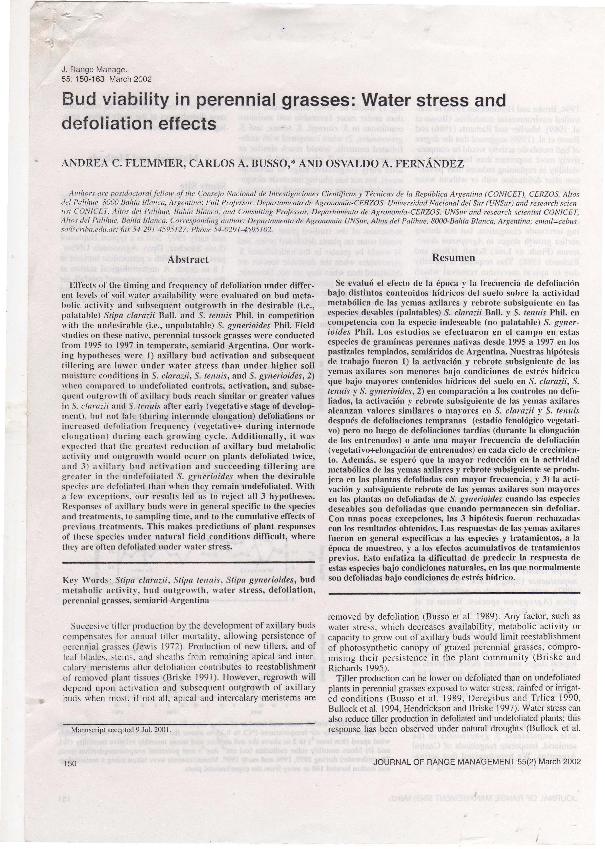Mostrar el registro sencillo del ítem
dc.contributor.author
Flemmer, Andrea Cecilia

dc.contributor.author
Busso, Carlos Alberto

dc.contributor.author
Fernandez, Osvaldo Alberto

dc.date.available
2018-01-10T16:46:44Z
dc.date.issued
2002-03
dc.identifier.citation
Flemmer, Andrea Cecilia; Fernandez, Osvaldo Alberto; Busso, Carlos Alberto; Bud viability in perennial grasses: Water stress and defoliation effects; Society for Range Management; Journal Of Range Management; 55; 2; 3-2002; 150-163
dc.identifier.issn
0022-409X
dc.identifier.uri
http://hdl.handle.net/11336/32809
dc.description.abstract
Effects of the timing and frequency of defoliation under different levels of soil water availability were evaluated on bud metabolic activity and subsequent outgrowth in the desirable (i.e., palatable) Stipa clarazii Ball. and S. tenuis Phil. in competition with the undesirable (i.e., unpalatable) S. gynerioides Phil. Field studies on these native, perennial tussock grasses were conducted from 1995 to 1997 in temperate, semiarid Argentina. Our working hypotheses were 1) axillary bud activation and subsequent tillering are lower under water stress than under higher soil moisture conditions in S. clarazii, S. tenuis, and S. gynerioides, 2) when compared to undefoliated controls, activation, and subsequent outgrowth of axillary buds reach similar or greater values in S. clarazii and S. tenuis after early (vegetative stage of development), but not late (during internode elongation) defoliations or increased defoliation frequency (vegetative+ during internode elongation) during each growing cycle. Additionally, it was expected that the greatest reduction of axillary bud metabolic activity and outgrowth would ocurr on plants defoliated twice, and 3) axillary bud activation and succeeding tillering are greater in the undefoliated S. gynerioides when the desirable species are defoliated than when they remain undefoliated. With a few exceptions, our results led us to reject all 3 hypotheses. Responses of axillary buds were in general specific to the species and treatments, to sampling time, and to the cumulative effects of previous treatments. This makes predictions of plant responses of these species under natural field conditions difficult, where they are often defoliated under water stress.
dc.format
application/pdf
dc.language.iso
spa
dc.publisher
Society for Range Management

dc.rights
info:eu-repo/semantics/openAccess
dc.rights.uri
https://creativecommons.org/licenses/by-nc-sa/2.5/ar/
dc.subject
Nassella
dc.subject
Semiarid Grasslands
dc.subject
Stipa Gynerioides
dc.subject
Stipa Tenuis
dc.subject
Buds
dc.subject
Nassella Tenuis
dc.subject
Stipa Clarazii
dc.subject.classification
Agricultura

dc.subject.classification
Agricultura, Silvicultura y Pesca

dc.subject.classification
CIENCIAS AGRÍCOLAS

dc.title
Bud viability in perennial grasses: Water stress and defoliation effects
dc.type
info:eu-repo/semantics/article
dc.type
info:ar-repo/semantics/artículo
dc.type
info:eu-repo/semantics/publishedVersion
dc.date.updated
2017-12-12T19:54:39Z
dc.journal.volume
55
dc.journal.number
2
dc.journal.pagination
150-163
dc.journal.pais
Estados Unidos

dc.journal.ciudad
Lawrence
dc.description.fil
Fil: Flemmer, Andrea Cecilia. Consejo Nacional de Investigaciones Científicas y Técnicas. Centro Científico Tecnológico Conicet - Bahía Blanca. Centro de Recursos Naturales Renovables de la Zona Semiárida. Universidad Nacional del Sur. Centro de Recursos Naturales Renovables de la Zona Semiárida; Argentina
dc.description.fil
Fil: Busso, Carlos Alberto. Consejo Nacional de Investigaciones Científicas y Técnicas. Centro Científico Tecnológico Conicet - Bahía Blanca. Centro de Recursos Naturales Renovables de la Zona Semiárida. Universidad Nacional del Sur. Centro de Recursos Naturales Renovables de la Zona Semiárida; Argentina
dc.description.fil
Fil: Fernandez, Osvaldo Alberto. Consejo Nacional de Investigaciones Científicas y Técnicas. Centro Científico Tecnológico Conicet - Bahía Blanca. Centro de Recursos Naturales Renovables de la Zona Semiárida. Universidad Nacional del Sur. Centro de Recursos Naturales Renovables de la Zona Semiárida; Argentina
dc.journal.title
Journal Of Range Management

dc.relation.alternativeid
info:eu-repo/semantics/altIdentifier/url/https://journals.uair.arizona.edu/index.php/jrm/article/view/9702
dc.relation.alternativeid
info:eu-repo/semantics/altIdentifier/doi/http://dx.doi.org/10.2458/azu_jrm_v55i2_flemmer
Archivos asociados
